Construction Practice & Management: Industry Analysis and Report
VerifiedAdded on 2022/08/12
|12
|4129
|69
Report
AI Summary
This report delves into the multifaceted realm of construction practice and management. It begins by examining the fundamental attributes of construction management, emphasizing the critical balance between time and cost constraints. The report explores the development of the construction industry, outlining the roles of various professionals and the procedural activities involved, such as design, implementation, and maintenance. It details the scope and linkages between key construction parties, including owners, contractors, and designers, and analyzes different types of contractual work. The report also discusses the evolution of construction companies, their structures, and the importance of employee management and ethical considerations. Furthermore, it identifies different types of construction companies and their key features, recommending the most suitable type for a given scenario. The report also analyzes the relationships between construction companies and the factors that differentiate construction contracts and tenders. Finally, it explores modern construction processes and techniques, including precast panel systems, 3D volumetric construction, and contract planning techniques for micro and macro projects, offering a comprehensive overview of the industry's current landscape.
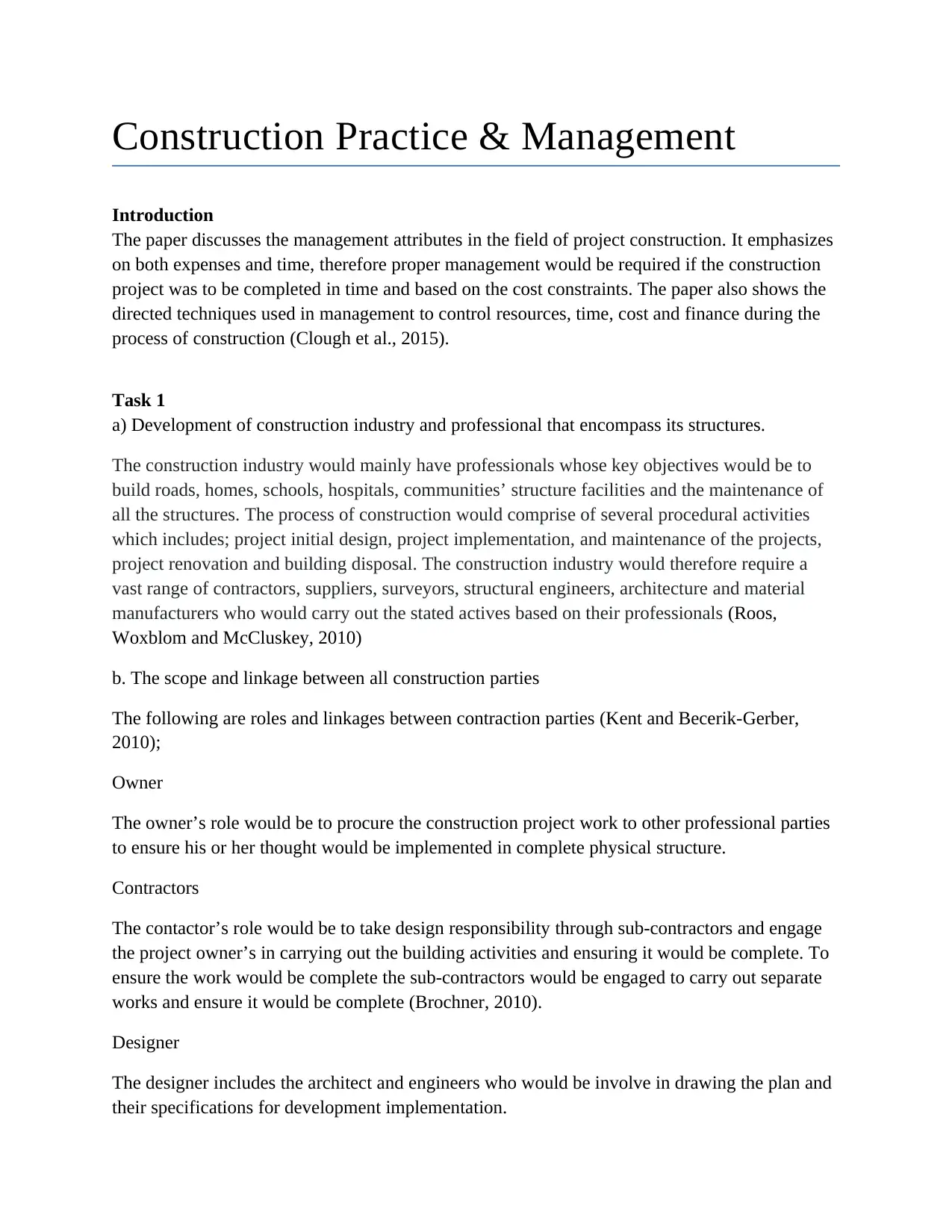
Construction Practice & Management
Introduction
The paper discusses the management attributes in the field of project construction. It emphasizes
on both expenses and time, therefore proper management would be required if the construction
project was to be completed in time and based on the cost constraints. The paper also shows the
directed techniques used in management to control resources, time, cost and finance during the
process of construction (Clough et al., 2015).
Task 1
a) Development of construction industry and professional that encompass its structures.
The construction industry would mainly have professionals whose key objectives would be to
build roads, homes, schools, hospitals, communities’ structure facilities and the maintenance of
all the structures. The process of construction would comprise of several procedural activities
which includes; project initial design, project implementation, and maintenance of the projects,
project renovation and building disposal. The construction industry would therefore require a
vast range of contractors, suppliers, surveyors, structural engineers, architecture and material
manufacturers who would carry out the stated actives based on their professionals (Roos,
Woxblom and McCluskey, 2010)
b. The scope and linkage between all construction parties
The following are roles and linkages between contraction parties (Kent and Becerik-Gerber,
2010);
Owner
The owner’s role would be to procure the construction project work to other professional parties
to ensure his or her thought would be implemented in complete physical structure.
Contractors
The contactor’s role would be to take design responsibility through sub-contractors and engage
the project owner’s in carrying out the building activities and ensuring it would be complete. To
ensure the work would be complete the sub-contractors would be engaged to carry out separate
works and ensure it would be complete (Brochner, 2010).
Designer
The designer includes the architect and engineers who would be involve in drawing the plan and
their specifications for development implementation.
Introduction
The paper discusses the management attributes in the field of project construction. It emphasizes
on both expenses and time, therefore proper management would be required if the construction
project was to be completed in time and based on the cost constraints. The paper also shows the
directed techniques used in management to control resources, time, cost and finance during the
process of construction (Clough et al., 2015).
Task 1
a) Development of construction industry and professional that encompass its structures.
The construction industry would mainly have professionals whose key objectives would be to
build roads, homes, schools, hospitals, communities’ structure facilities and the maintenance of
all the structures. The process of construction would comprise of several procedural activities
which includes; project initial design, project implementation, and maintenance of the projects,
project renovation and building disposal. The construction industry would therefore require a
vast range of contractors, suppliers, surveyors, structural engineers, architecture and material
manufacturers who would carry out the stated actives based on their professionals (Roos,
Woxblom and McCluskey, 2010)
b. The scope and linkage between all construction parties
The following are roles and linkages between contraction parties (Kent and Becerik-Gerber,
2010);
Owner
The owner’s role would be to procure the construction project work to other professional parties
to ensure his or her thought would be implemented in complete physical structure.
Contractors
The contactor’s role would be to take design responsibility through sub-contractors and engage
the project owner’s in carrying out the building activities and ensuring it would be complete. To
ensure the work would be complete the sub-contractors would be engaged to carry out separate
works and ensure it would be complete (Brochner, 2010).
Designer
The designer includes the architect and engineers who would be involve in drawing the plan and
their specifications for development implementation.
Paraphrase This Document
Need a fresh take? Get an instant paraphrase of this document with our AI Paraphraser

c. Types of contractual work tendered by contractors and its justification for the given industrial
complex scenario.
Several types of contract work would be tendered and managed by contractors who would
organize the overall process needed to effectively create future construction projects. The
following are four types of contracts in constructions that would include (Adriaanse, 2016);
Time and material contracts
Unit price contracts
Cost contracts
Lump sum contracts
The initiation of multiple contractual procedures and system engaging would assist one to
generate a proper idea that would help deliver proper services or goods at appropriate time
frame contract. The correct time scale management and consideration of price techniques
would help this aspect.
d) Development of construction industry in terms of company structures, its employees and
contracted work.
In this aspect, the proper use of materials, employees and proper management would create the
appropriate mechanism that would base on long-term support and development follow-up.
Improving the productivity of construction industry labor, together with the technical services
in construction industry, can also discuss acceptable solutions focused on a justifiable
commitment to work. The employee requirement, planning of the structures and the appropriate
management in these scenarios are thus followed by various processes of innovation
accompanied by the major construction activities. The construction industry would focus on the
different approaches relating to economical analysis and evaluation of the factors related to the
current market (Liu et al., 2013).
The performance framework that would be initiated in this aspect with the design innovative
approaches would help review the characteristics of the business in addition to the
competitiveness of the market. The defined structure-based dynamics mechanism would helps
generate product that would be homogeneous in their features to ensure that the system-would
be engaged based on production processes, product management, services as well as activities
related to the wider market in this aspect. Assembling of construction materials, innovation of
products and considering supportive plan work would contemplate further progress and
development. The level of market dominance would define the size of the firms' and the number
of employees according to the construction ratio. Based on homogeneity and moving resources
the construction company would concentrate on price influence and output quantity.
Considering construction project employees, it would be important to focus on different
departments for the project, such as project planners, mechanical engineers, electrician’s
financial planners and field work staff. The construction work would have to follow the specific
complex scenario.
Several types of contract work would be tendered and managed by contractors who would
organize the overall process needed to effectively create future construction projects. The
following are four types of contracts in constructions that would include (Adriaanse, 2016);
Time and material contracts
Unit price contracts
Cost contracts
Lump sum contracts
The initiation of multiple contractual procedures and system engaging would assist one to
generate a proper idea that would help deliver proper services or goods at appropriate time
frame contract. The correct time scale management and consideration of price techniques
would help this aspect.
d) Development of construction industry in terms of company structures, its employees and
contracted work.
In this aspect, the proper use of materials, employees and proper management would create the
appropriate mechanism that would base on long-term support and development follow-up.
Improving the productivity of construction industry labor, together with the technical services
in construction industry, can also discuss acceptable solutions focused on a justifiable
commitment to work. The employee requirement, planning of the structures and the appropriate
management in these scenarios are thus followed by various processes of innovation
accompanied by the major construction activities. The construction industry would focus on the
different approaches relating to economical analysis and evaluation of the factors related to the
current market (Liu et al., 2013).
The performance framework that would be initiated in this aspect with the design innovative
approaches would help review the characteristics of the business in addition to the
competitiveness of the market. The defined structure-based dynamics mechanism would helps
generate product that would be homogeneous in their features to ensure that the system-would
be engaged based on production processes, product management, services as well as activities
related to the wider market in this aspect. Assembling of construction materials, innovation of
products and considering supportive plan work would contemplate further progress and
development. The level of market dominance would define the size of the firms' and the number
of employees according to the construction ratio. Based on homogeneity and moving resources
the construction company would concentrate on price influence and output quantity.
Considering construction project employees, it would be important to focus on different
departments for the project, such as project planners, mechanical engineers, electrician’s
financial planners and field work staff. The construction work would have to follow the specific
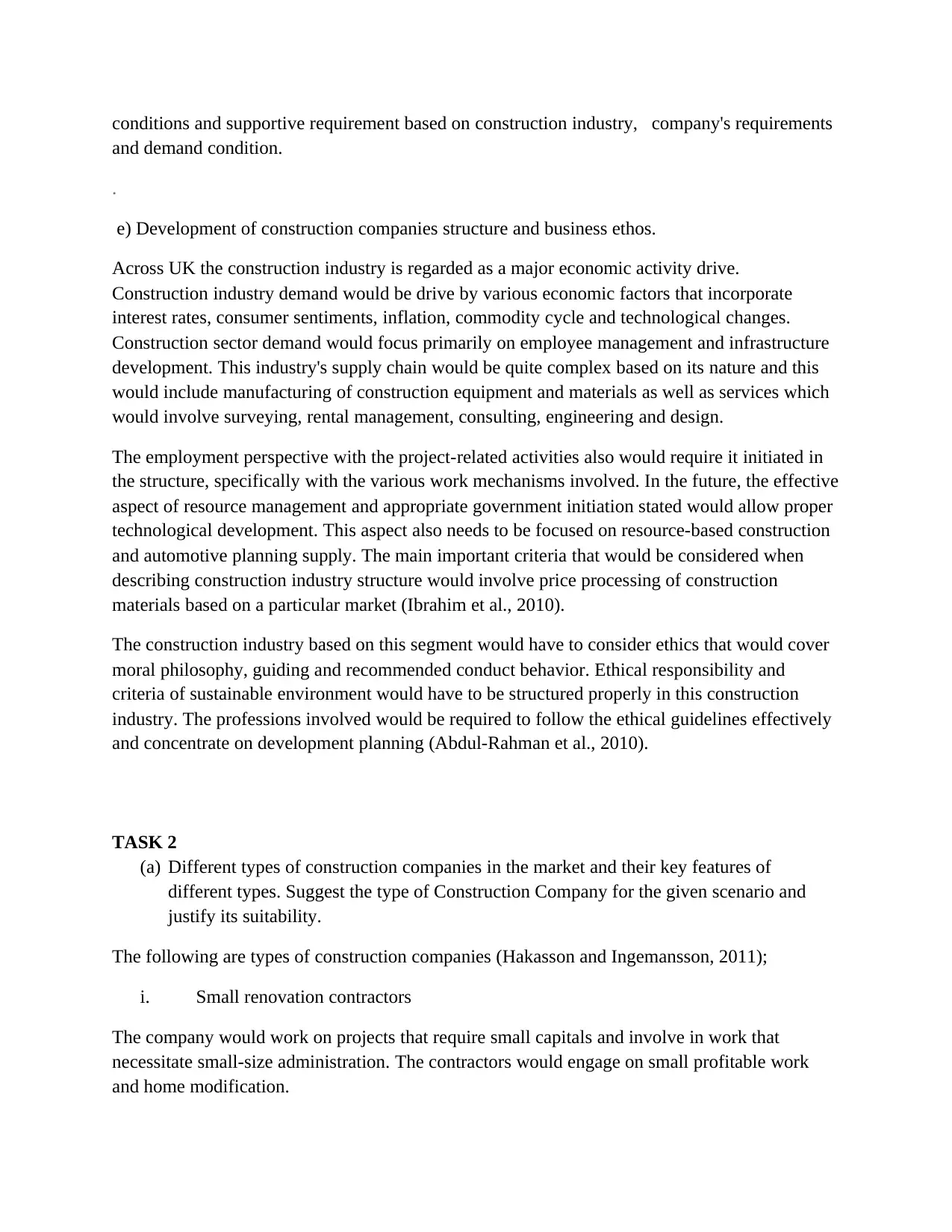
conditions and supportive requirement based on construction industry, company's requirements
and demand condition.
.
e) Development of construction companies structure and business ethos.
Across UK the construction industry is regarded as a major economic activity drive.
Construction industry demand would be drive by various economic factors that incorporate
interest rates, consumer sentiments, inflation, commodity cycle and technological changes.
Construction sector demand would focus primarily on employee management and infrastructure
development. This industry's supply chain would be quite complex based on its nature and this
would include manufacturing of construction equipment and materials as well as services which
would involve surveying, rental management, consulting, engineering and design.
The employment perspective with the project-related activities also would require it initiated in
the structure, specifically with the various work mechanisms involved. In the future, the effective
aspect of resource management and appropriate government initiation stated would allow proper
technological development. This aspect also needs to be focused on resource-based construction
and automotive planning supply. The main important criteria that would be considered when
describing construction industry structure would involve price processing of construction
materials based on a particular market (Ibrahim et al., 2010).
The construction industry based on this segment would have to consider ethics that would cover
moral philosophy, guiding and recommended conduct behavior. Ethical responsibility and
criteria of sustainable environment would have to be structured properly in this construction
industry. The professions involved would be required to follow the ethical guidelines effectively
and concentrate on development planning (Abdul-Rahman et al., 2010).
TASK 2
(a) Different types of construction companies in the market and their key features of
different types. Suggest the type of Construction Company for the given scenario and
justify its suitability.
The following are types of construction companies (Hakasson and Ingemansson, 2011);
i. Small renovation contractors
The company would work on projects that require small capitals and involve in work that
necessitate small-size administration. The contractors would engage on small profitable work
and home modification.
and demand condition.
.
e) Development of construction companies structure and business ethos.
Across UK the construction industry is regarded as a major economic activity drive.
Construction industry demand would be drive by various economic factors that incorporate
interest rates, consumer sentiments, inflation, commodity cycle and technological changes.
Construction sector demand would focus primarily on employee management and infrastructure
development. This industry's supply chain would be quite complex based on its nature and this
would include manufacturing of construction equipment and materials as well as services which
would involve surveying, rental management, consulting, engineering and design.
The employment perspective with the project-related activities also would require it initiated in
the structure, specifically with the various work mechanisms involved. In the future, the effective
aspect of resource management and appropriate government initiation stated would allow proper
technological development. This aspect also needs to be focused on resource-based construction
and automotive planning supply. The main important criteria that would be considered when
describing construction industry structure would involve price processing of construction
materials based on a particular market (Ibrahim et al., 2010).
The construction industry based on this segment would have to consider ethics that would cover
moral philosophy, guiding and recommended conduct behavior. Ethical responsibility and
criteria of sustainable environment would have to be structured properly in this construction
industry. The professions involved would be required to follow the ethical guidelines effectively
and concentrate on development planning (Abdul-Rahman et al., 2010).
TASK 2
(a) Different types of construction companies in the market and their key features of
different types. Suggest the type of Construction Company for the given scenario and
justify its suitability.
The following are types of construction companies (Hakasson and Ingemansson, 2011);
i. Small renovation contractors
The company would work on projects that require small capitals and involve in work that
necessitate small-size administration. The contractors would engage on small profitable work
and home modification.
⊘ This is a preview!⊘
Do you want full access?
Subscribe today to unlock all pages.

Trusted by 1+ million students worldwide
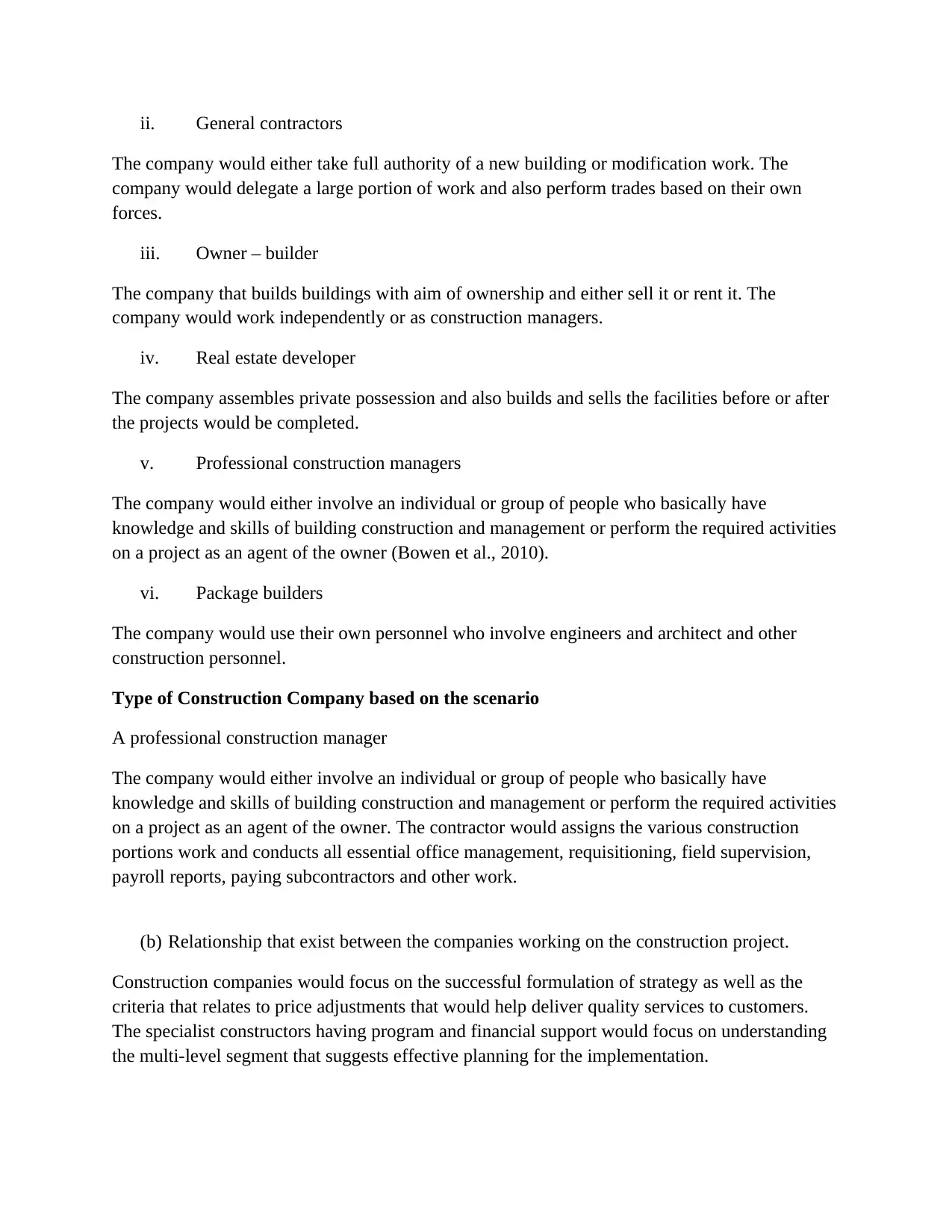
ii. General contractors
The company would either take full authority of a new building or modification work. The
company would delegate a large portion of work and also perform trades based on their own
forces.
iii. Owner – builder
The company that builds buildings with aim of ownership and either sell it or rent it. The
company would work independently or as construction managers.
iv. Real estate developer
The company assembles private possession and also builds and sells the facilities before or after
the projects would be completed.
v. Professional construction managers
The company would either involve an individual or group of people who basically have
knowledge and skills of building construction and management or perform the required activities
on a project as an agent of the owner (Bowen et al., 2010).
vi. Package builders
The company would use their own personnel who involve engineers and architect and other
construction personnel.
Type of Construction Company based on the scenario
A professional construction manager
The company would either involve an individual or group of people who basically have
knowledge and skills of building construction and management or perform the required activities
on a project as an agent of the owner. The contractor would assigns the various construction
portions work and conducts all essential office management, requisitioning, field supervision,
payroll reports, paying subcontractors and other work.
(b) Relationship that exist between the companies working on the construction project.
Construction companies would focus on the successful formulation of strategy as well as the
criteria that relates to price adjustments that would help deliver quality services to customers.
The specialist constructors having program and financial support would focus on understanding
the multi-level segment that suggests effective planning for the implementation.
The company would either take full authority of a new building or modification work. The
company would delegate a large portion of work and also perform trades based on their own
forces.
iii. Owner – builder
The company that builds buildings with aim of ownership and either sell it or rent it. The
company would work independently or as construction managers.
iv. Real estate developer
The company assembles private possession and also builds and sells the facilities before or after
the projects would be completed.
v. Professional construction managers
The company would either involve an individual or group of people who basically have
knowledge and skills of building construction and management or perform the required activities
on a project as an agent of the owner (Bowen et al., 2010).
vi. Package builders
The company would use their own personnel who involve engineers and architect and other
construction personnel.
Type of Construction Company based on the scenario
A professional construction manager
The company would either involve an individual or group of people who basically have
knowledge and skills of building construction and management or perform the required activities
on a project as an agent of the owner. The contractor would assigns the various construction
portions work and conducts all essential office management, requisitioning, field supervision,
payroll reports, paying subcontractors and other work.
(b) Relationship that exist between the companies working on the construction project.
Construction companies would focus on the successful formulation of strategy as well as the
criteria that relates to price adjustments that would help deliver quality services to customers.
The specialist constructors having program and financial support would focus on understanding
the multi-level segment that suggests effective planning for the implementation.
Paraphrase This Document
Need a fresh take? Get an instant paraphrase of this document with our AI Paraphraser
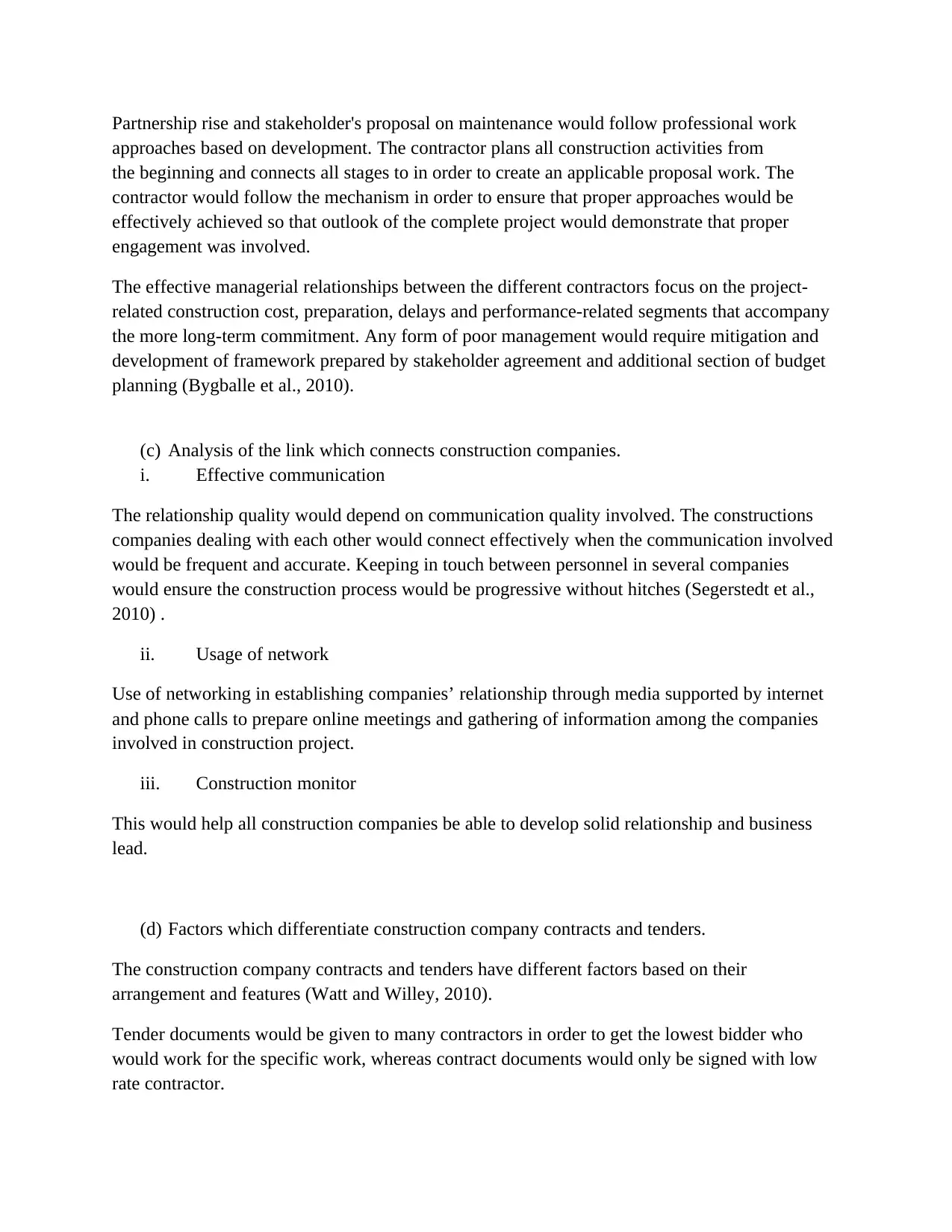
Partnership rise and stakeholder's proposal on maintenance would follow professional work
approaches based on development. The contractor plans all construction activities from
the beginning and connects all stages to in order to create an applicable proposal work. The
contractor would follow the mechanism in order to ensure that proper approaches would be
effectively achieved so that outlook of the complete project would demonstrate that proper
engagement was involved.
The effective managerial relationships between the different contractors focus on the project-
related construction cost, preparation, delays and performance-related segments that accompany
the more long-term commitment. Any form of poor management would require mitigation and
development of framework prepared by stakeholder agreement and additional section of budget
planning (Bygballe et al., 2010).
(c) Analysis of the link which connects construction companies.
i. Effective communication
The relationship quality would depend on communication quality involved. The constructions
companies dealing with each other would connect effectively when the communication involved
would be frequent and accurate. Keeping in touch between personnel in several companies
would ensure the construction process would be progressive without hitches (Segerstedt et al.,
2010) .
ii. Usage of network
Use of networking in establishing companies’ relationship through media supported by internet
and phone calls to prepare online meetings and gathering of information among the companies
involved in construction project.
iii. Construction monitor
This would help all construction companies be able to develop solid relationship and business
lead.
(d) Factors which differentiate construction company contracts and tenders.
The construction company contracts and tenders have different factors based on their
arrangement and features (Watt and Willey, 2010).
Tender documents would be given to many contractors in order to get the lowest bidder who
would work for the specific work, whereas contract documents would only be signed with low
rate contractor.
approaches based on development. The contractor plans all construction activities from
the beginning and connects all stages to in order to create an applicable proposal work. The
contractor would follow the mechanism in order to ensure that proper approaches would be
effectively achieved so that outlook of the complete project would demonstrate that proper
engagement was involved.
The effective managerial relationships between the different contractors focus on the project-
related construction cost, preparation, delays and performance-related segments that accompany
the more long-term commitment. Any form of poor management would require mitigation and
development of framework prepared by stakeholder agreement and additional section of budget
planning (Bygballe et al., 2010).
(c) Analysis of the link which connects construction companies.
i. Effective communication
The relationship quality would depend on communication quality involved. The constructions
companies dealing with each other would connect effectively when the communication involved
would be frequent and accurate. Keeping in touch between personnel in several companies
would ensure the construction process would be progressive without hitches (Segerstedt et al.,
2010) .
ii. Usage of network
Use of networking in establishing companies’ relationship through media supported by internet
and phone calls to prepare online meetings and gathering of information among the companies
involved in construction project.
iii. Construction monitor
This would help all construction companies be able to develop solid relationship and business
lead.
(d) Factors which differentiate construction company contracts and tenders.
The construction company contracts and tenders have different factors based on their
arrangement and features (Watt and Willey, 2010).
Tender documents would be given to many contractors in order to get the lowest bidder who
would work for the specific work, whereas contract documents would only be signed with low
rate contractor.
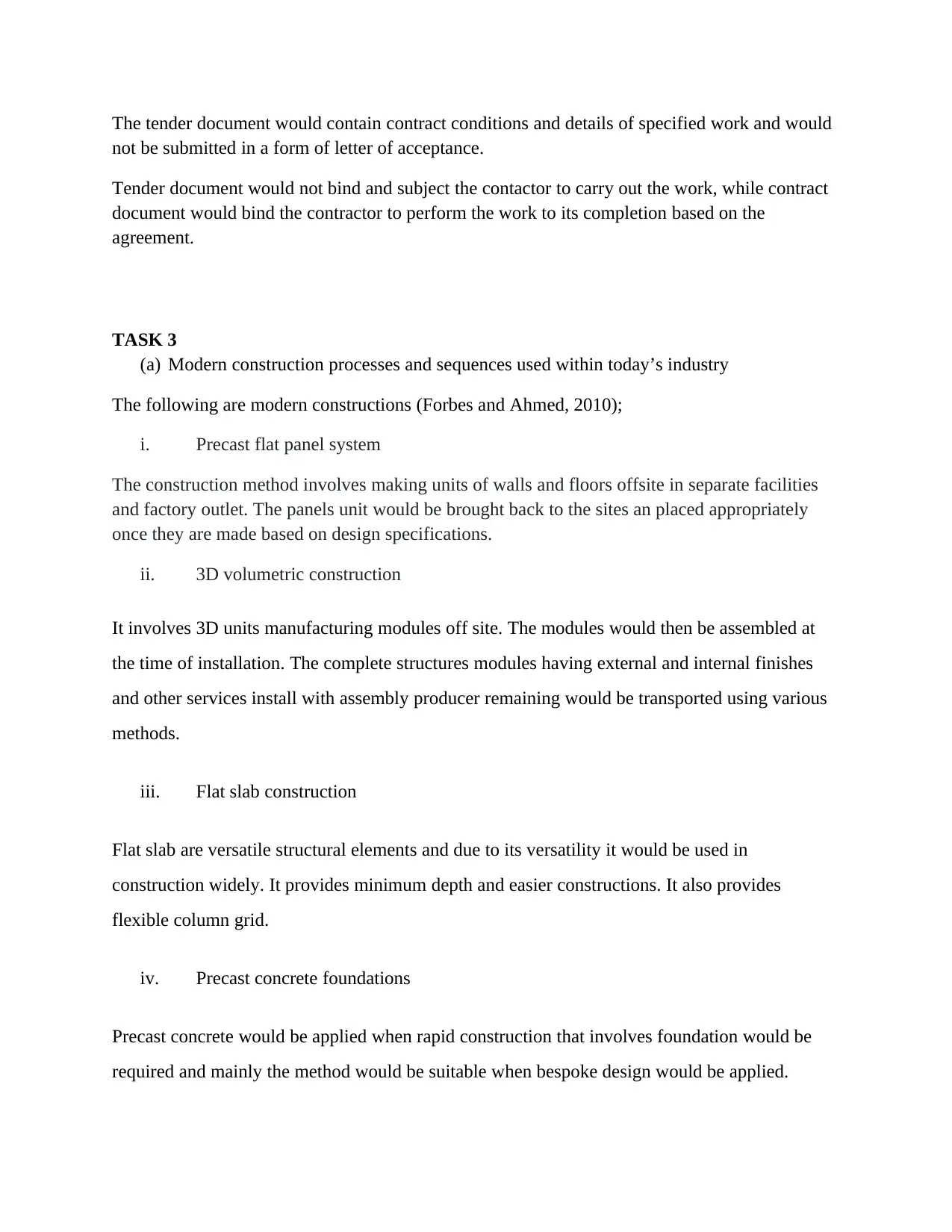
The tender document would contain contract conditions and details of specified work and would
not be submitted in a form of letter of acceptance.
Tender document would not bind and subject the contactor to carry out the work, while contract
document would bind the contractor to perform the work to its completion based on the
agreement.
TASK 3
(a) Modern construction processes and sequences used within today’s industry
The following are modern constructions (Forbes and Ahmed, 2010);
i. Precast flat panel system
The construction method involves making units of walls and floors offsite in separate facilities
and factory outlet. The panels unit would be brought back to the sites an placed appropriately
once they are made based on design specifications.
ii. 3D volumetric construction
It involves 3D units manufacturing modules off site. The modules would then be assembled at
the time of installation. The complete structures modules having external and internal finishes
and other services install with assembly producer remaining would be transported using various
methods.
iii. Flat slab construction
Flat slab are versatile structural elements and due to its versatility it would be used in
construction widely. It provides minimum depth and easier constructions. It also provides
flexible column grid.
iv. Precast concrete foundations
Precast concrete would be applied when rapid construction that involves foundation would be
required and mainly the method would be suitable when bespoke design would be applied.
not be submitted in a form of letter of acceptance.
Tender document would not bind and subject the contactor to carry out the work, while contract
document would bind the contractor to perform the work to its completion based on the
agreement.
TASK 3
(a) Modern construction processes and sequences used within today’s industry
The following are modern constructions (Forbes and Ahmed, 2010);
i. Precast flat panel system
The construction method involves making units of walls and floors offsite in separate facilities
and factory outlet. The panels unit would be brought back to the sites an placed appropriately
once they are made based on design specifications.
ii. 3D volumetric construction
It involves 3D units manufacturing modules off site. The modules would then be assembled at
the time of installation. The complete structures modules having external and internal finishes
and other services install with assembly producer remaining would be transported using various
methods.
iii. Flat slab construction
Flat slab are versatile structural elements and due to its versatility it would be used in
construction widely. It provides minimum depth and easier constructions. It also provides
flexible column grid.
iv. Precast concrete foundations
Precast concrete would be applied when rapid construction that involves foundation would be
required and mainly the method would be suitable when bespoke design would be applied.
⊘ This is a preview!⊘
Do you want full access?
Subscribe today to unlock all pages.

Trusted by 1+ million students worldwide

Foundation in this case would be constructed off site and be brought to the site for assembling.
(b) Contract planning techniques used within micro and macro projects.
The contract preparation techniques would be introduced in order to create and produce the
organized project outcomes as per the mechanism-based framework that connects with the
constriction of micro and macro project.
Micro planning strategy takes into account the practical consequences of the site forecasting the
relevant system integration and develops alternate strategies as per the future work participation
in this aspect The site-based planning and taking into account requirements based on the
information system will produce better techniques by considering modern infrastructure
(Tryggested et al., 2010).
Macro contract scheduling would support the multiplied association of system and considers the
organized possibilities as per the given aspect of the work process which provides the suitable
connectivity-related commitment. Furthermore, the detection would connect with the physical
structure and takes into account the criteria of macro-management that would identify which
process the relevant system would adjust to in order to connects with contracts (Kassem and
Succar, 2017).
(c) BIM impacts upon operations and construction companies
Engagement between contractors and BIM would allow designers to initiate effective prospect of
work that would manage the whole project. Project related aspects and maintenance of the
construction program would be vital for this scenario. BIM have four levels which would
connect with the procured project and cost, facilities and time management frame of this
segment.
BIM would have an impact on cost of modeling approaches and programs of construction which
would be applicable on the work process that would be generated on this segment. It is also
important in handling any kind of work that begin in preparing and removing the problems and
conflicts in this aspect so that various work consequences can be identified. BIM's would access
the project work and process execution and also link with the construction process prerequisite
(Fadeyi, 2017).
(d) Development of construction in terms of innovation, designs, and within contracts for
micro and macro projects, and BIM interrelation.
Innovation concept would engage with relevant system-based connection in order to provide the
proper BIM segment interrelationship. The incorporation of systematic management
(b) Contract planning techniques used within micro and macro projects.
The contract preparation techniques would be introduced in order to create and produce the
organized project outcomes as per the mechanism-based framework that connects with the
constriction of micro and macro project.
Micro planning strategy takes into account the practical consequences of the site forecasting the
relevant system integration and develops alternate strategies as per the future work participation
in this aspect The site-based planning and taking into account requirements based on the
information system will produce better techniques by considering modern infrastructure
(Tryggested et al., 2010).
Macro contract scheduling would support the multiplied association of system and considers the
organized possibilities as per the given aspect of the work process which provides the suitable
connectivity-related commitment. Furthermore, the detection would connect with the physical
structure and takes into account the criteria of macro-management that would identify which
process the relevant system would adjust to in order to connects with contracts (Kassem and
Succar, 2017).
(c) BIM impacts upon operations and construction companies
Engagement between contractors and BIM would allow designers to initiate effective prospect of
work that would manage the whole project. Project related aspects and maintenance of the
construction program would be vital for this scenario. BIM have four levels which would
connect with the procured project and cost, facilities and time management frame of this
segment.
BIM would have an impact on cost of modeling approaches and programs of construction which
would be applicable on the work process that would be generated on this segment. It is also
important in handling any kind of work that begin in preparing and removing the problems and
conflicts in this aspect so that various work consequences can be identified. BIM's would access
the project work and process execution and also link with the construction process prerequisite
(Fadeyi, 2017).
(d) Development of construction in terms of innovation, designs, and within contracts for
micro and macro projects, and BIM interrelation.
Innovation concept would engage with relevant system-based connection in order to provide the
proper BIM segment interrelationship. The incorporation of systematic management
Paraphrase This Document
Need a fresh take? Get an instant paraphrase of this document with our AI Paraphraser
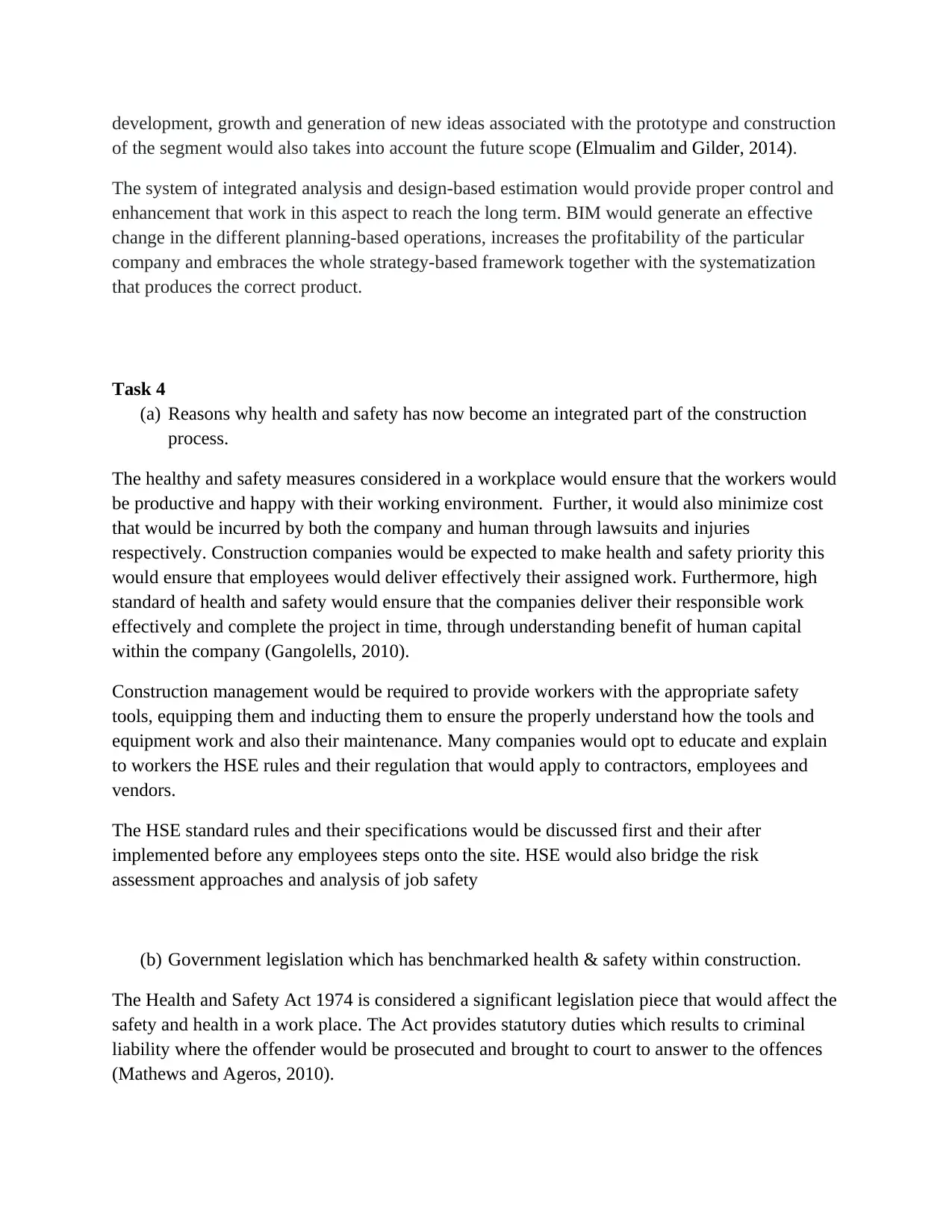
development, growth and generation of new ideas associated with the prototype and construction
of the segment would also takes into account the future scope (Elmualim and Gilder, 2014).
The system of integrated analysis and design-based estimation would provide proper control and
enhancement that work in this aspect to reach the long term. BIM would generate an effective
change in the different planning-based operations, increases the profitability of the particular
company and embraces the whole strategy-based framework together with the systematization
that produces the correct product.
Task 4
(a) Reasons why health and safety has now become an integrated part of the construction
process.
The healthy and safety measures considered in a workplace would ensure that the workers would
be productive and happy with their working environment. Further, it would also minimize cost
that would be incurred by both the company and human through lawsuits and injuries
respectively. Construction companies would be expected to make health and safety priority this
would ensure that employees would deliver effectively their assigned work. Furthermore, high
standard of health and safety would ensure that the companies deliver their responsible work
effectively and complete the project in time, through understanding benefit of human capital
within the company (Gangolells, 2010).
Construction management would be required to provide workers with the appropriate safety
tools, equipping them and inducting them to ensure the properly understand how the tools and
equipment work and also their maintenance. Many companies would opt to educate and explain
to workers the HSE rules and their regulation that would apply to contractors, employees and
vendors.
The HSE standard rules and their specifications would be discussed first and their after
implemented before any employees steps onto the site. HSE would also bridge the risk
assessment approaches and analysis of job safety
(b) Government legislation which has benchmarked health & safety within construction.
The Health and Safety Act 1974 is considered a significant legislation piece that would affect the
safety and health in a work place. The Act provides statutory duties which results to criminal
liability where the offender would be prosecuted and brought to court to answer to the offences
(Mathews and Ageros, 2010).
of the segment would also takes into account the future scope (Elmualim and Gilder, 2014).
The system of integrated analysis and design-based estimation would provide proper control and
enhancement that work in this aspect to reach the long term. BIM would generate an effective
change in the different planning-based operations, increases the profitability of the particular
company and embraces the whole strategy-based framework together with the systematization
that produces the correct product.
Task 4
(a) Reasons why health and safety has now become an integrated part of the construction
process.
The healthy and safety measures considered in a workplace would ensure that the workers would
be productive and happy with their working environment. Further, it would also minimize cost
that would be incurred by both the company and human through lawsuits and injuries
respectively. Construction companies would be expected to make health and safety priority this
would ensure that employees would deliver effectively their assigned work. Furthermore, high
standard of health and safety would ensure that the companies deliver their responsible work
effectively and complete the project in time, through understanding benefit of human capital
within the company (Gangolells, 2010).
Construction management would be required to provide workers with the appropriate safety
tools, equipping them and inducting them to ensure the properly understand how the tools and
equipment work and also their maintenance. Many companies would opt to educate and explain
to workers the HSE rules and their regulation that would apply to contractors, employees and
vendors.
The HSE standard rules and their specifications would be discussed first and their after
implemented before any employees steps onto the site. HSE would also bridge the risk
assessment approaches and analysis of job safety
(b) Government legislation which has benchmarked health & safety within construction.
The Health and Safety Act 1974 is considered a significant legislation piece that would affect the
safety and health in a work place. The Act provides statutory duties which results to criminal
liability where the offender would be prosecuted and brought to court to answer to the offences
(Mathews and Ageros, 2010).

The vital safety and health regulations construction regulation 2015, that is be applied in
European directives and UK law, this ensures minimum implementation requirement would be
applied at temporary and work sites that are mobile. The regulation would require creation of
two documents which includes; construction phase plan and health sand safe file. The plan
would be expected to have details on safety and health arrangements on the project sites. The
files would contain the structure information and would be available to the project owner and
construction contractors mandated to carry out the work.
c) The role of collaboration and communication in ensuring safe working practices.
Effective safe working practices would be ensured when proper communication modes and
availability of collaboration would be provided in a construction site. It would be important
when strong collaboration team that would be capable of initiating unity in a construction site
would be available. The following factors would be considered effective in providing
collaboration role of ensuring safety working practices (Fulford and Standing, 2014);
Collaboration within the construction industry would improve effectively workers safety
Collaboration within the construction industry would result to better and effective
coordination
Collaboration within the construction industry would improve emergency responses
Communication approaches within the construction industry would be of significance in
ensuring that safety practices would be achieved effectively, the following factors would be
considered effective in providing communication role of ensuring safety working practices;
Initiation of proper communication mode on safety and health measures would provide
easy understanding of estimated goals and expectation that would carried out in a
construction industry
Effective communication would also provide team building improvement this would
ensure all safety measures would be tackled easily as one team.
(e) How the construction industry has benefited through changes in health & safety
legislation.
• Construction companies always would be required to emphasize their priorities on safety
• It is critical that the company's employees undergo extensive training in an efficient manner.
• By collecting employee input, construction firms would easily understand the extension to
which they have been able to incorporate their safety and health practices
(e) The impact of health & safety legislation, how it has evolved the drivers for it, and its
advantages or weaknesses within construction.
European directives and UK law, this ensures minimum implementation requirement would be
applied at temporary and work sites that are mobile. The regulation would require creation of
two documents which includes; construction phase plan and health sand safe file. The plan
would be expected to have details on safety and health arrangements on the project sites. The
files would contain the structure information and would be available to the project owner and
construction contractors mandated to carry out the work.
c) The role of collaboration and communication in ensuring safe working practices.
Effective safe working practices would be ensured when proper communication modes and
availability of collaboration would be provided in a construction site. It would be important
when strong collaboration team that would be capable of initiating unity in a construction site
would be available. The following factors would be considered effective in providing
collaboration role of ensuring safety working practices (Fulford and Standing, 2014);
Collaboration within the construction industry would improve effectively workers safety
Collaboration within the construction industry would result to better and effective
coordination
Collaboration within the construction industry would improve emergency responses
Communication approaches within the construction industry would be of significance in
ensuring that safety practices would be achieved effectively, the following factors would be
considered effective in providing communication role of ensuring safety working practices;
Initiation of proper communication mode on safety and health measures would provide
easy understanding of estimated goals and expectation that would carried out in a
construction industry
Effective communication would also provide team building improvement this would
ensure all safety measures would be tackled easily as one team.
(e) How the construction industry has benefited through changes in health & safety
legislation.
• Construction companies always would be required to emphasize their priorities on safety
• It is critical that the company's employees undergo extensive training in an efficient manner.
• By collecting employee input, construction firms would easily understand the extension to
which they have been able to incorporate their safety and health practices
(e) The impact of health & safety legislation, how it has evolved the drivers for it, and its
advantages or weaknesses within construction.
⊘ This is a preview!⊘
Do you want full access?
Subscribe today to unlock all pages.

Trusted by 1+ million students worldwide
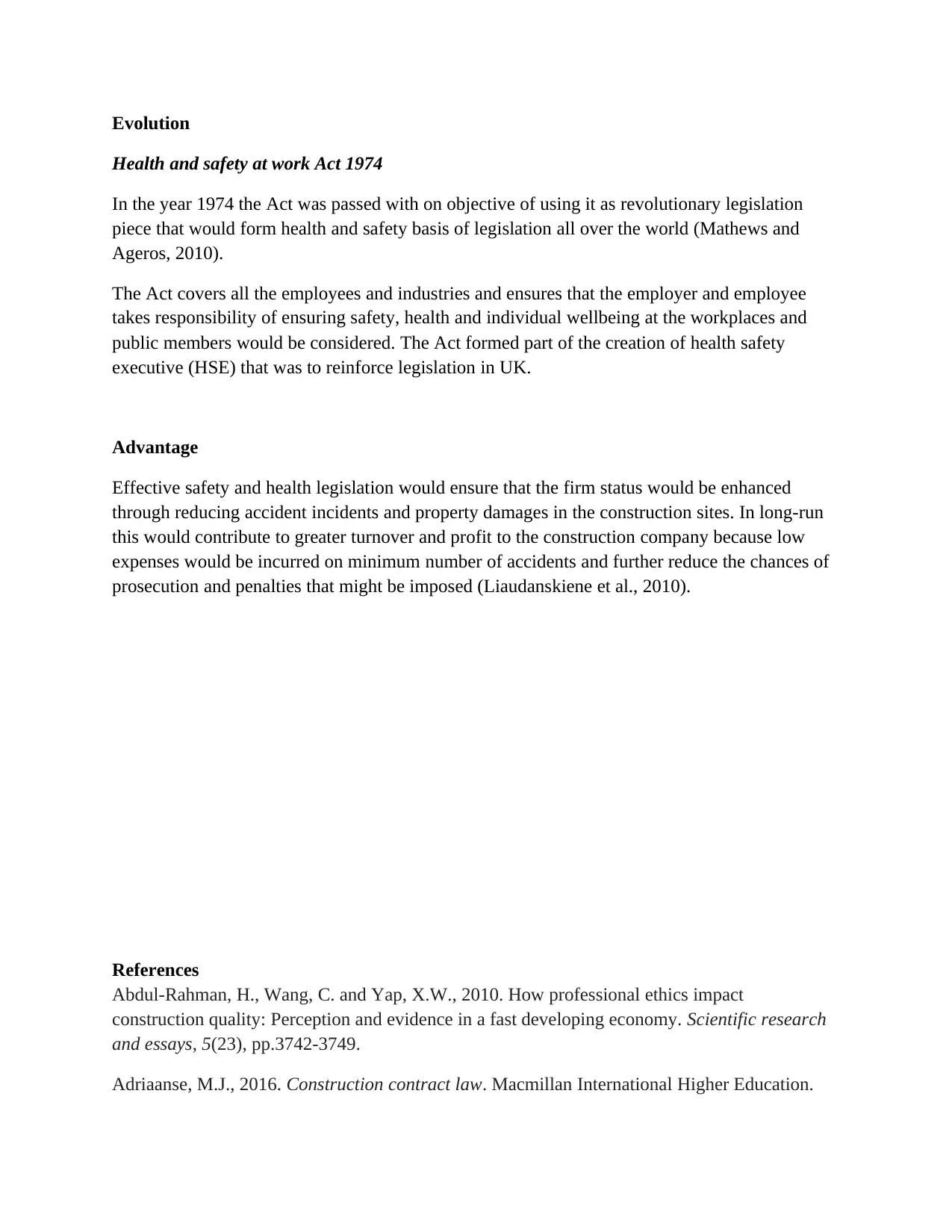
Evolution
Health and safety at work Act 1974
In the year 1974 the Act was passed with on objective of using it as revolutionary legislation
piece that would form health and safety basis of legislation all over the world (Mathews and
Ageros, 2010).
The Act covers all the employees and industries and ensures that the employer and employee
takes responsibility of ensuring safety, health and individual wellbeing at the workplaces and
public members would be considered. The Act formed part of the creation of health safety
executive (HSE) that was to reinforce legislation in UK.
Advantage
Effective safety and health legislation would ensure that the firm status would be enhanced
through reducing accident incidents and property damages in the construction sites. In long-run
this would contribute to greater turnover and profit to the construction company because low
expenses would be incurred on minimum number of accidents and further reduce the chances of
prosecution and penalties that might be imposed (Liaudanskiene et al., 2010).
References
Abdul-Rahman, H., Wang, C. and Yap, X.W., 2010. How professional ethics impact
construction quality: Perception and evidence in a fast developing economy. Scientific research
and essays, 5(23), pp.3742-3749.
Adriaanse, M.J., 2016. Construction contract law. Macmillan International Higher Education.
Health and safety at work Act 1974
In the year 1974 the Act was passed with on objective of using it as revolutionary legislation
piece that would form health and safety basis of legislation all over the world (Mathews and
Ageros, 2010).
The Act covers all the employees and industries and ensures that the employer and employee
takes responsibility of ensuring safety, health and individual wellbeing at the workplaces and
public members would be considered. The Act formed part of the creation of health safety
executive (HSE) that was to reinforce legislation in UK.
Advantage
Effective safety and health legislation would ensure that the firm status would be enhanced
through reducing accident incidents and property damages in the construction sites. In long-run
this would contribute to greater turnover and profit to the construction company because low
expenses would be incurred on minimum number of accidents and further reduce the chances of
prosecution and penalties that might be imposed (Liaudanskiene et al., 2010).
References
Abdul-Rahman, H., Wang, C. and Yap, X.W., 2010. How professional ethics impact
construction quality: Perception and evidence in a fast developing economy. Scientific research
and essays, 5(23), pp.3742-3749.
Adriaanse, M.J., 2016. Construction contract law. Macmillan International Higher Education.
Paraphrase This Document
Need a fresh take? Get an instant paraphrase of this document with our AI Paraphraser
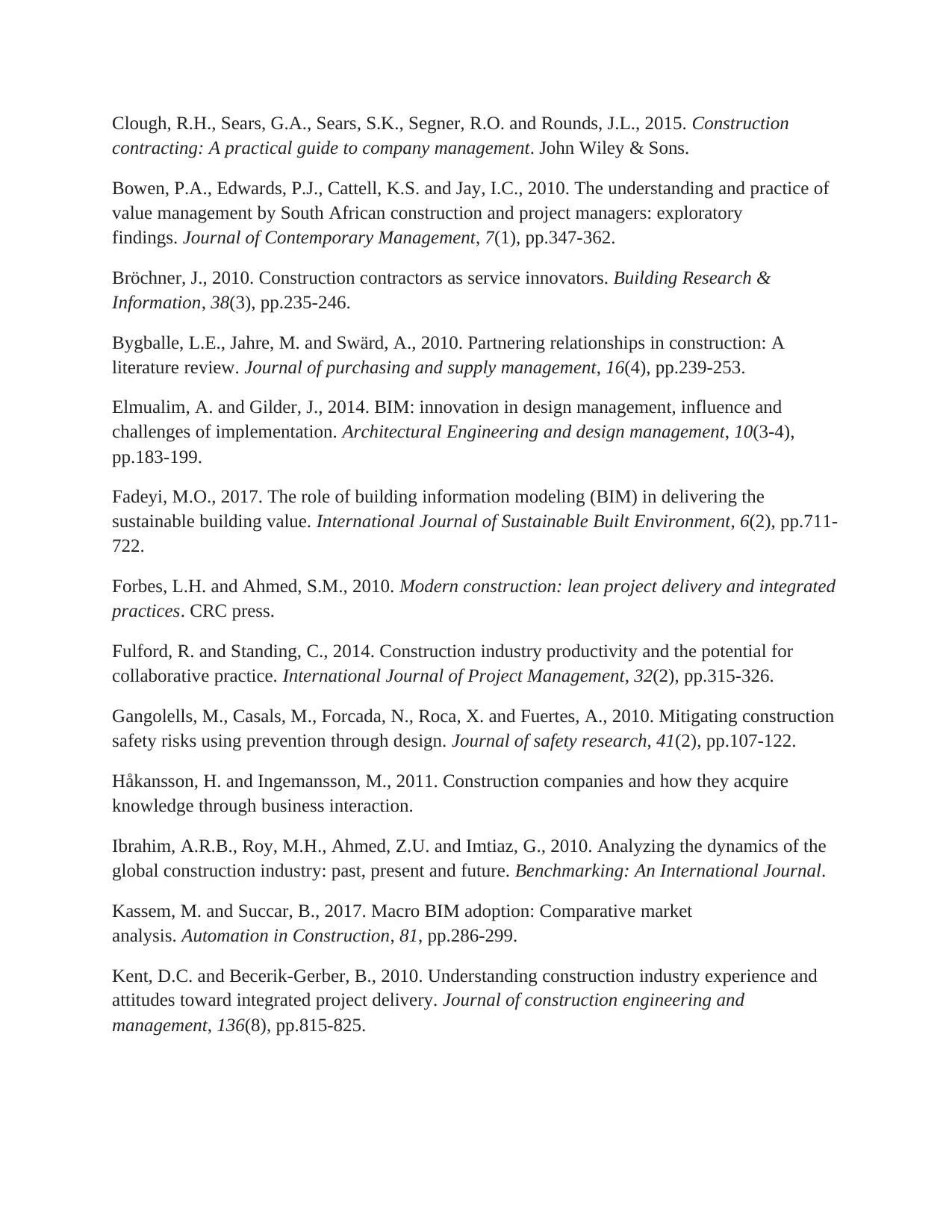
Clough, R.H., Sears, G.A., Sears, S.K., Segner, R.O. and Rounds, J.L., 2015. Construction
contracting: A practical guide to company management. John Wiley & Sons.
Bowen, P.A., Edwards, P.J., Cattell, K.S. and Jay, I.C., 2010. The understanding and practice of
value management by South African construction and project managers: exploratory
findings. Journal of Contemporary Management, 7(1), pp.347-362.
Bröchner, J., 2010. Construction contractors as service innovators. Building Research &
Information, 38(3), pp.235-246.
Bygballe, L.E., Jahre, M. and Swärd, A., 2010. Partnering relationships in construction: A
literature review. Journal of purchasing and supply management, 16(4), pp.239-253.
Elmualim, A. and Gilder, J., 2014. BIM: innovation in design management, influence and
challenges of implementation. Architectural Engineering and design management, 10(3-4),
pp.183-199.
Fadeyi, M.O., 2017. The role of building information modeling (BIM) in delivering the
sustainable building value. International Journal of Sustainable Built Environment, 6(2), pp.711-
722.
Forbes, L.H. and Ahmed, S.M., 2010. Modern construction: lean project delivery and integrated
practices. CRC press.
Fulford, R. and Standing, C., 2014. Construction industry productivity and the potential for
collaborative practice. International Journal of Project Management, 32(2), pp.315-326.
Gangolells, M., Casals, M., Forcada, N., Roca, X. and Fuertes, A., 2010. Mitigating construction
safety risks using prevention through design. Journal of safety research, 41(2), pp.107-122.
Håkansson, H. and Ingemansson, M., 2011. Construction companies and how they acquire
knowledge through business interaction.
Ibrahim, A.R.B., Roy, M.H., Ahmed, Z.U. and Imtiaz, G., 2010. Analyzing the dynamics of the
global construction industry: past, present and future. Benchmarking: An International Journal.
Kassem, M. and Succar, B., 2017. Macro BIM adoption: Comparative market
analysis. Automation in Construction, 81, pp.286-299.
Kent, D.C. and Becerik-Gerber, B., 2010. Understanding construction industry experience and
attitudes toward integrated project delivery. Journal of construction engineering and
management, 136(8), pp.815-825.
contracting: A practical guide to company management. John Wiley & Sons.
Bowen, P.A., Edwards, P.J., Cattell, K.S. and Jay, I.C., 2010. The understanding and practice of
value management by South African construction and project managers: exploratory
findings. Journal of Contemporary Management, 7(1), pp.347-362.
Bröchner, J., 2010. Construction contractors as service innovators. Building Research &
Information, 38(3), pp.235-246.
Bygballe, L.E., Jahre, M. and Swärd, A., 2010. Partnering relationships in construction: A
literature review. Journal of purchasing and supply management, 16(4), pp.239-253.
Elmualim, A. and Gilder, J., 2014. BIM: innovation in design management, influence and
challenges of implementation. Architectural Engineering and design management, 10(3-4),
pp.183-199.
Fadeyi, M.O., 2017. The role of building information modeling (BIM) in delivering the
sustainable building value. International Journal of Sustainable Built Environment, 6(2), pp.711-
722.
Forbes, L.H. and Ahmed, S.M., 2010. Modern construction: lean project delivery and integrated
practices. CRC press.
Fulford, R. and Standing, C., 2014. Construction industry productivity and the potential for
collaborative practice. International Journal of Project Management, 32(2), pp.315-326.
Gangolells, M., Casals, M., Forcada, N., Roca, X. and Fuertes, A., 2010. Mitigating construction
safety risks using prevention through design. Journal of safety research, 41(2), pp.107-122.
Håkansson, H. and Ingemansson, M., 2011. Construction companies and how they acquire
knowledge through business interaction.
Ibrahim, A.R.B., Roy, M.H., Ahmed, Z.U. and Imtiaz, G., 2010. Analyzing the dynamics of the
global construction industry: past, present and future. Benchmarking: An International Journal.
Kassem, M. and Succar, B., 2017. Macro BIM adoption: Comparative market
analysis. Automation in Construction, 81, pp.286-299.
Kent, D.C. and Becerik-Gerber, B., 2010. Understanding construction industry experience and
attitudes toward integrated project delivery. Journal of construction engineering and
management, 136(8), pp.815-825.
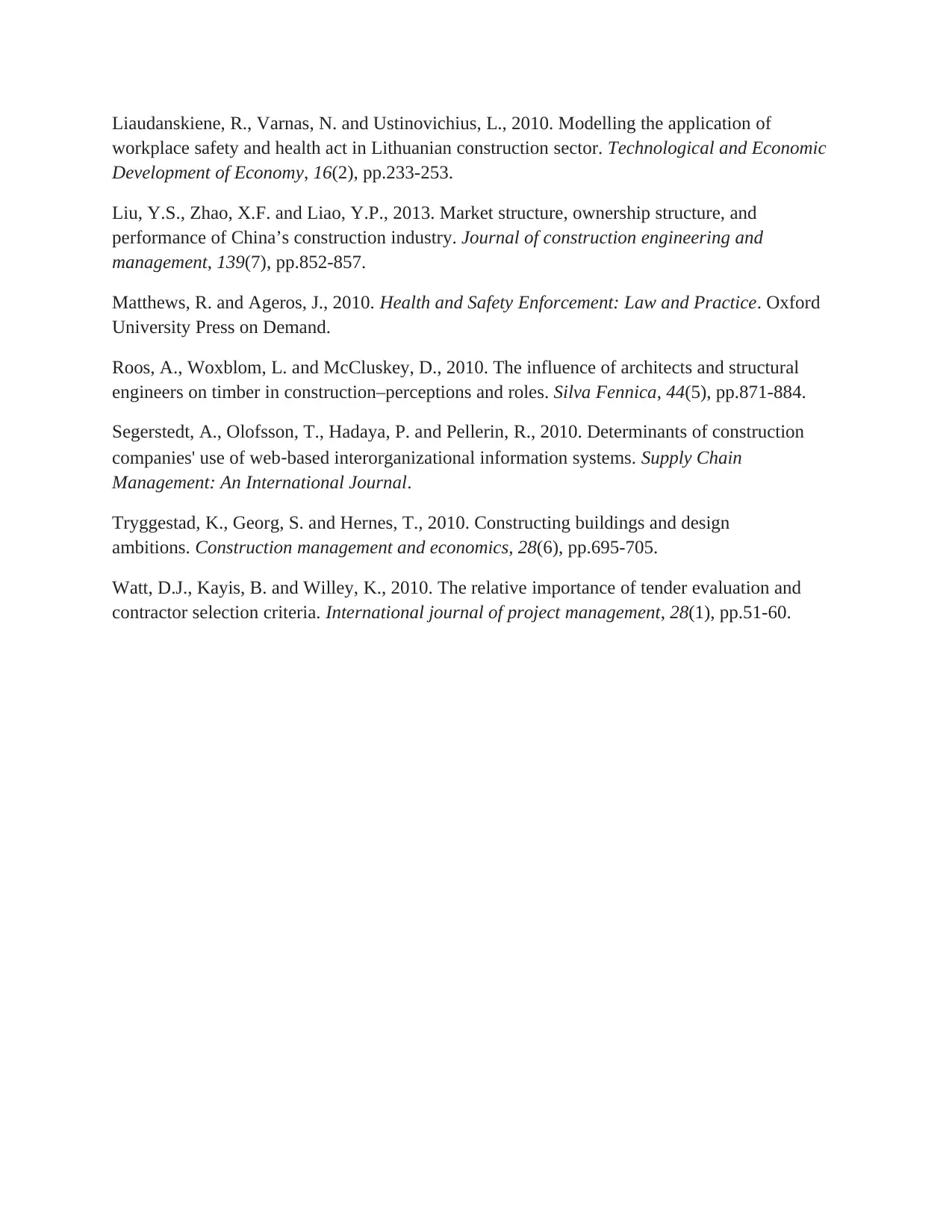
Liaudanskiene, R., Varnas, N. and Ustinovichius, L., 2010. Modelling the application of
workplace safety and health act in Lithuanian construction sector. Technological and Economic
Development of Economy, 16(2), pp.233-253.
Liu, Y.S., Zhao, X.F. and Liao, Y.P., 2013. Market structure, ownership structure, and
performance of China’s construction industry. Journal of construction engineering and
management, 139(7), pp.852-857.
Matthews, R. and Ageros, J., 2010. Health and Safety Enforcement: Law and Practice. Oxford
University Press on Demand.
Roos, A., Woxblom, L. and McCluskey, D., 2010. The influence of architects and structural
engineers on timber in construction–perceptions and roles. Silva Fennica, 44(5), pp.871-884.
Segerstedt, A., Olofsson, T., Hadaya, P. and Pellerin, R., 2010. Determinants of construction
companies' use of web‐based interorganizational information systems. Supply Chain
Management: An International Journal.
Tryggestad, K., Georg, S. and Hernes, T., 2010. Constructing buildings and design
ambitions. Construction management and economics, 28(6), pp.695-705.
Watt, D.J., Kayis, B. and Willey, K., 2010. The relative importance of tender evaluation and
contractor selection criteria. International journal of project management, 28(1), pp.51-60.
workplace safety and health act in Lithuanian construction sector. Technological and Economic
Development of Economy, 16(2), pp.233-253.
Liu, Y.S., Zhao, X.F. and Liao, Y.P., 2013. Market structure, ownership structure, and
performance of China’s construction industry. Journal of construction engineering and
management, 139(7), pp.852-857.
Matthews, R. and Ageros, J., 2010. Health and Safety Enforcement: Law and Practice. Oxford
University Press on Demand.
Roos, A., Woxblom, L. and McCluskey, D., 2010. The influence of architects and structural
engineers on timber in construction–perceptions and roles. Silva Fennica, 44(5), pp.871-884.
Segerstedt, A., Olofsson, T., Hadaya, P. and Pellerin, R., 2010. Determinants of construction
companies' use of web‐based interorganizational information systems. Supply Chain
Management: An International Journal.
Tryggestad, K., Georg, S. and Hernes, T., 2010. Constructing buildings and design
ambitions. Construction management and economics, 28(6), pp.695-705.
Watt, D.J., Kayis, B. and Willey, K., 2010. The relative importance of tender evaluation and
contractor selection criteria. International journal of project management, 28(1), pp.51-60.
⊘ This is a preview!⊘
Do you want full access?
Subscribe today to unlock all pages.

Trusted by 1+ million students worldwide
1 out of 12
Related Documents
Your All-in-One AI-Powered Toolkit for Academic Success.
+13062052269
info@desklib.com
Available 24*7 on WhatsApp / Email
![[object Object]](/_next/static/media/star-bottom.7253800d.svg)
Unlock your academic potential
Copyright © 2020–2025 A2Z Services. All Rights Reserved. Developed and managed by ZUCOL.





